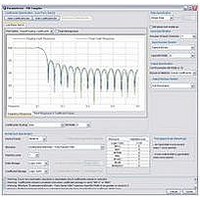IPR-FIR Altera, IPR-FIR Datasheet - Page 40

IPR-FIR
Manufacturer Part Number
IPR-FIR
Description
IP CORE Renewal Of IP-FIR
Manufacturer
Altera
Type
MegaCorer
Specifications of IPR-FIR
Software Application
IP CORE, DSP Filters And Transforms
Supported Families
Arria GX, Arria II GX, Cyclone, HardCopy, Stratix
Core Architecture
FPGA
Core Sub-architecture
Arria, Cyclone, Stratix
Rohs Compliant
NA
Function
Finite Impulse Response Compiler
License
Renewal License
Lead Free Status / RoHS Status
na
Lead Free Status / RoHS Status
na
3–16
Resource Estimates
Filter Design Tips
FIR Compiler User Guide
1
The FIR Compiler automatically calculates and displays the estimated resources that
the filter will use in the Resource Estimates box of the Architecture Specification
section (Parameterize FIR Compiler page).
The FIR Compiler provides the estimated size in embedded memory blocks, DSP
blocks, and logic cells. The Throughput box displays the number of clock cycles
required to compute the result
Figure 3–10. Resource Estimates
The resource usage estimate may differ from Quartus II resource usage by +/- 30%,
depending on which optimization method you use in the Quartus II software.
Additionally, the resource estimator is less accurate for small filters (500 logic cells or
less). For small filters, compile the design in the Quartus II software to obtain the
resource usage.
This section provides some additional tips for using the FIR Compiler:
■
■
■
■
To prevent high-pass filters from rolling off near Nyquist, select an odd number of
taps.
You can import coefficients from the MATLAB software into the FIR Compiler via
a text file. Simply save your coefficients as fixed or floating-point numbers to an
ASCII file, one coefficient per line.
To make a quadrature phase shift keying (QPSK), quadrature amplitude
modulation (QAM), or phase shift keying (PSK) modulator or demodulator using
the FIR Compiler, create a multichannel filter by indicating two or more channels
on the input specification area.
A comb filter is a filter that has repetitive notches. You can make a comb filter by
first making a single-notch filter, and then using sub-sampling. The process of sub-
sampling reflects or mirrors the notches in the frequency domain at all frequencies
above Nyquist.
(Figure
3–10).
© December 2010 Altera Corporation
Chapter 3: Parameter Settings
Resource Estimates















